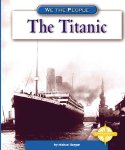Through the Looking Glass Children's Book Reviews
The Titanic
Nonfiction
For ages 8 to 10
Compass Point Books, 2004 ISBN: 075650614X
If you wanted to cross the Atlantic in the early 1900’s you had to travel by ship. At that time two shipping companies, the Cunard Line and the White Star Line, competed to make the fasted and biggest steamships. In 1907 Cunard launched the Lusitania, which was the world’s largest ship. With the support of the J.P. Morgan - who owned the White Star Line - J. Bruce Ismay began to build a trio of ships for the White Star Line which would be bigger still. They were the Olympic, Titanic and Britannic.
Ismay wanted to create a ship which was large and luxurious, a floating hotel in which the passenger rooms would be “of unrivalled magnificence,” and this is exactly what he did. The Titanic had every convenience on board and “the latest safety features.” There was a wireless radio, a swimming pool, a gym, and a library on board. One thing it did not have was enough lifeboats for the more than 3,000 people who could be accommodated on the ship. Another problem which arose was that people began to think that the Titanic was “unsinkable.” The passengers and crew who sailed on Titanic’s maiden voyage learned that nothing is unsinkable, under the right circumstances.
The Titanic sailed from Southampton, England on April 10th, 1912. The crossing began well with calm seas, and Captain Smith was able to increase the ship’s speed every day. However, as they approached North America, more and more reports came in about the presence of floating ice in the sea lanes ahead. The captain did change the route of the Titanic, going further south than he otherwise would have done, but he did not decrease his speed and at around 11:40 on the night of April 14th, the Titanic struck an iceberg. It was a glancing blow but it was enough to put a long jagged 300 foot hole in the side of the great ship.
What followed was a terrible couple of hours. Many mistakes were made which cost countless people their lives. Many passengers and crew members showed great courage, risking death so that others might survive. In the end more than 1,500 people died in the disaster.
Something good did come out of this awful event however. Shipping lines made sure that there were enough lifeboats on their ships to accommodate all the people on their ships. Ships would also have to keep their radios on all day and all night, just in case a distress call was sent out.
This excellent title in the “We the people” series describes very well what lead to the building of the Titanic, and what brought about its spectacular downfall. Young readers who do not know the details of the Titanic story will learn a great deal from this book and will probably find themselves quite fascinated by the descriptions of the ship’s short life and dramatic loss.




